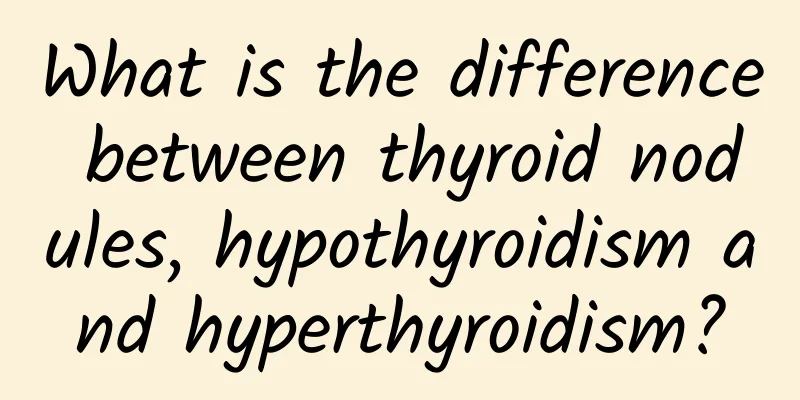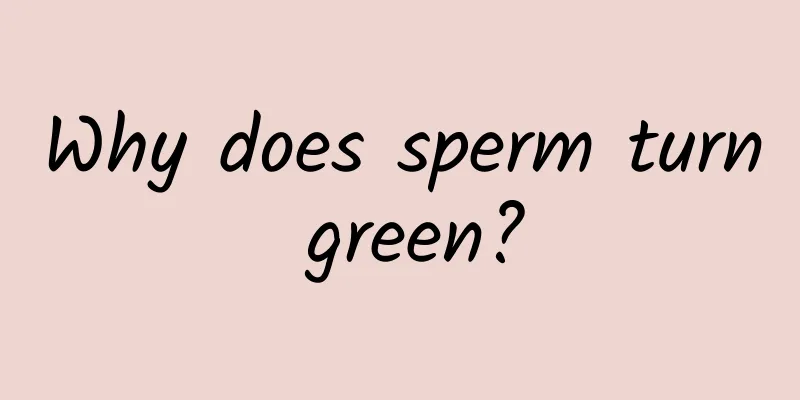What is the difference between thyroid nodules, hypothyroidism and hyperthyroidism?

|
Thyroid nodules, hyperthyroidism and hypothyroidism all refer to clinical diseases. Although the word "thyroid" is used in all three diseases, they are essentially different. Today, I will talk about the obvious differences between thyroid nodules, hyperthyroidism and hypothyroidism. Thyroid nodules The thyroid gland (also called thyroid nodules and thyroid adenomas) is one of the common clinical diseases. The clinical distinction between thyroid nodules and thyroid adenomas mainly depends on the size. A tumor is larger than one centimeter, while a nodule is smaller than one centimeter. When it comes to tumors, the first thing people think of is whether it is benign or malignant? Thyroid adenomas are generally benign tumors, so don't be too nervous. Benign: The neck lumps are mostly single, grow slowly, and may have compression symptoms when they are large. The lumps move up and down with swallowing, are smooth, soft in texture, and are round or oval in shape, which can cause hyperthyroidism. Malignant: The texture is hard. Gender and thyroid function: Although thyroid diseases are more common in women, once men become ill, the condition is usually more complicated than that in women. Thyroid symptoms: The patient's neck below the Adam's apple is swollen, the patient's food intake and number of meals increase, and the patient often feels hungry and has a tendency to not feel full, while also losing weight. Hyperthyroidism Hyperthyroidism is also one of the common thyroid diseases in clinical practice. Its symptoms are basically the same as those of thyroid nodules. The difference is that thyroid nodules (tumors) are enlarged below the Adam's apple in the front of the neck, while hyperthyroidism is bulging of the eyeballs. Hypothyroidism Hypothyroidism, also known as "hypothyroidism", is an endocrine disease characterized by low thyroid function and reduced synthesis and secretion of thyroid hormone. It is caused by insufficient synthesis or secretion of thyroid hormone by the thyroid gland or insensitivity of surrounding tissues to thyroid hormone. It can occur at any age. The thyroid gland is located below the Adam's apple in the front of the neck and is butterfly-shaped; in fact, all metabolic processes in the human body are affected by thyroid hormones. |
<<: Do you know the normal range of fingertip blood sugar?
>>: Thyroid nodules: five dietary considerations
Recommend
What is the probability of prostatic fluid leading to pregnancy?
Many people may find such a situation when they h...
Can an adult man's penis develop again?
Can the penis develop again? Men are very concern...
178 height standard weight
Male friends are very strict about their weight, ...
Do you eat amaranth root? What are the effects and functions of amaranth root?
When eating agarwood, do you only eat the leaves ...
Can Bactroban ointment be used on the glans penis?
Bactroban ointment can be applied to the glans pe...
How is epididymitis caused?
What is the cause of right epididymitis? Epididym...
How to treat severe premature ejaculation
I believe that everyone must be familiar with the...
How to treat prostate disease most effectively
Treating prostate disease is a difficult problem ...
How to treat a red spot on the penis
I believe everyone knows the importance of the pe...
Benefits of nourishing essence
There are more and more ways to nourish sperm, an...
Men often do these exercises to increase your sexual power
Regular exercise can not only strengthen the body...
Why is the glans penis a little yellow?
The glans penis is a very important organ for men...
There is a hard thing behind the testicle
Men should also regularly check for various disea...
Is it normal to keep ejaculating?
In daily life, it is quite common for male friend...
Is heel pain in men a sign of kidney deficiency?
Nowadays, our daily life, work pressure, and psyc...









